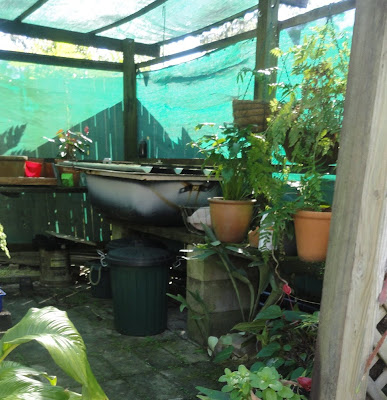Over the past few months our worm farm has gone from bad to worse. The farm was in an old bath tub (see above) that we bought cheaply at the recycle shop. I set it up a few years ago in the bush-house and since then we've been regularly harvesting worm castings and worm liquid. Then the rats discovered it. They found they could get in under the lid so Hanno attached a more secure lid for me. That worked for a while but they chewed a hole in the side of the tub where it had started to rust. There was no stopping them, and not only did they eat the food put in there for the worms, they ate the worms too! Has anyone else had that problem?

Eventually there were several points of entry.
When you have backyard livestock, whether it be worms, chickens, goats or a house cow, the feeds bins always have to be tight and secure, otherwise the rats and mice take over. We’ve always been mindful of this but nevertheless, the rats set up shop under the chook house and now that our old cat Hettie is no longer an active mouser, they’ve made themselves at home. We have a couple of pythons hanging around the neighbourhood but even they seem to have deserted this lost cause.
So I bought a smaller plastic worm farm. It’s made from recycled plastic, has four trays and best of all, it’s rat-proof. I set it up yesterday, following the simple instructions that came with it. The few worms the rats didn’t find and a new box full of worms have been installed to do their thing.
I love using worm castings and liquid in the garden and in pots. It’s the most gentle, but effective, fertiliser and adds beneficial microbes to the soil, another big bonus. We also use a lot of comfrey and now rarely have to buy any commercial fertiliser. This is a big saving when you garden almost year round and to have natural fertilisers like these means we can boost plant growth without adding anything we don’t want.

If you haven’t yet discovered how wonderful worm castings are, I encourage you to try them. One of the tricks to long term backyard vegetable production is to produce good quality organic food at the lowest possible cost. Saving seeds every year (as long as they're open pollinated/heirloom seeds) and making your own fertiliser will help you do that.

The new farm takes up a lot less room so I can use the extra space to sit more seedling trays.
There is a bit of cost in setting up a worm farm. You'll need a suitable container and worms, the rest of the farm can be set up with bits and pieces you have around the place. There are step-by-step instructions for setting up a bathtub farm from my original worm farm here. Here is some very good information and excellent photos about the value of worm castings and liquid. When you're set up, it will be one of the ways you can dispose of your organic waste and kitchen scraps instead of sending them to land fill.
If you're in the first year of your vegetable garden, it's best to grow the herb comfrey for your fertilising. Plant it on the edge of your garden where you don't want to plant anything else - it doesn't multiple out but it's difficult to remove if you want to move it. It will grow in almost any type of soil and likes a fair bit of water while it's establishing itself. Comfrey will grow quite rapidly from root cuttings that you can buy for a small cost or have given to you by another vegie gardener. Here is an old post about worm farm maintenance and making comfrey fertiliser. There is no other cost, except for your time and effort to grow it, and if you don't go ahead with your garden again next year, you haven't wasted too much.





